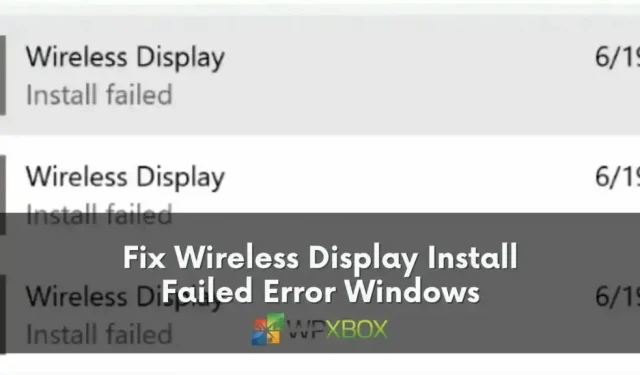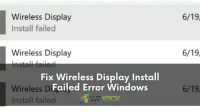The ability to smoothly project movies, images, web information, and media files from one device to another is a game-changer in today’s fast-paced digital environment. Users can benefit from this convenience thanks to Windows 11/10’s Wireless Display feature, which makes it simple to exchange content between compatible devices. Install Failed errors have been reported by some users while installing this practical feature on their computers. You may learn how to resolve the Wireless Display Setup Failed error on Windows by reading this post.
Why Does Windows Experience Wireless Display Install Failure Error?
After looking into the issue, we found five potential causes for the Install Failed error:
- Unstable Internet Connection: A weak or fluctuating internet connection can hinder the installation process, causing it to stall or fail altogether.
- Limited Internet Connection: If your system is restricted to a metered connection, you may not have sufficient bandwidth to complete the installation. Turning off the metered connection could resolve this issue.
- Corrupted System Files: Your system may be affected by a corruption error or inconsistency that interferes with the installation process. Consider using an alternative utility like Command Prompt to download and install the Wireless Display feature.
- Incompatible Hardware: Ensure your devices meet the hardware requirements for Wireless Display functionality; otherwise, you might face compatibility issues during installation.
- Outdated Drivers or Software: Keeping your device drivers and software up-to-date is crucial for smooth functioning; outdated components can cause conflicts and errors during installation.
Now that you are more aware of the potential causes of the error, let’s look at a solution for Windows’ can’t add wireless display error.
Repair Windows Wireless Display Setup Failed Error
We’ll go through every one of the potential and effective fixes for the Wireless display install failed error in Windows in this part. All of the following is covered:
- Turn Off Metered Connection
- Use DISM Command
- Change DNS
- Bypass WSUS With Registry
Now let’s take a closer look at each of these approaches.
1] Turn Off Metered Connection
Turning off the metered connection function in your Network and Internet settings may help if you’re getting the Wireless Display Setup Failed issue. This function restricts data consumption on your computer in order to save bandwidth, which could make installation difficult. To disconnect from the metered connection, just follow these easy steps:
- Press the Windows + I keys simultaneously to open the Settings app.
- Click on the Network and Internet category from the left pane to access Internet settings.
- Locate and click on the Properties option for your current internet connection.
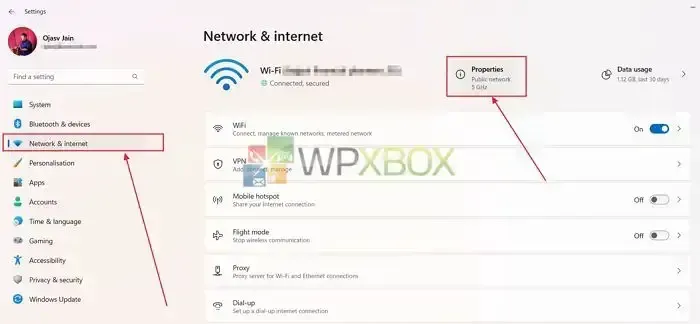
- In the Properties window, scroll down until you find the Metered Connection option.
- Ensure the Metered connection option is turned off; toggle off and close the Settings app.
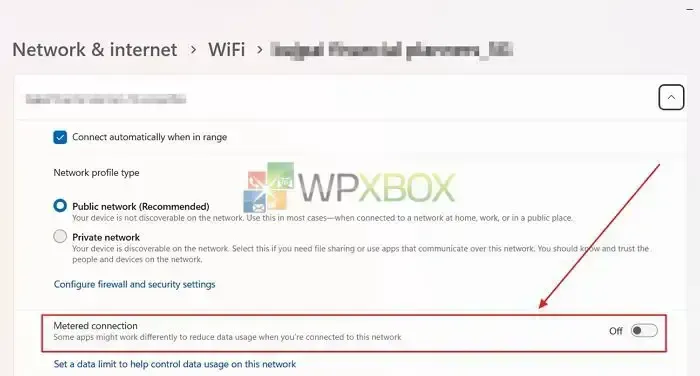
Check to see if the problem still exists after installing the Wireless Display option with metered connection disabled.
2] Use DISM Command
It is possible to mount, unmount, and repair Windows images using the robust command-line utility DISM. By using this program, you may immediately install the wireless display feature in Windows while avoiding any potential problems or inconsistencies that could have prevented the installation from succeeding. To install the wireless display capability using the DISM command, adhere to following steps:
- Launch Windows Terminal with administrative rights.
- Input the command as follows:
DISM /Online /Add-Capability /CapabilityName:App.WirelessDisplay.Connect~~~~0.0.1.0
- Press Enter to execute the command to attempt to install the wireless display feature.
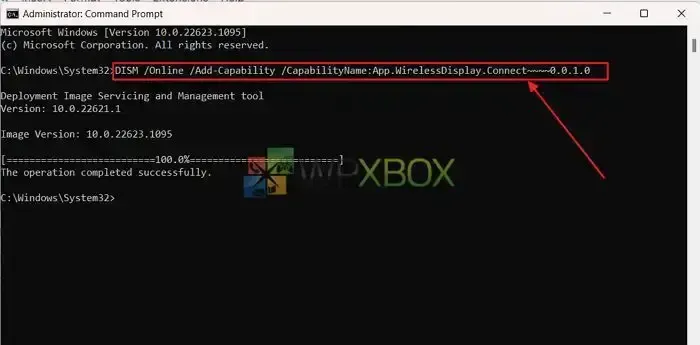
3] Change DNS
Altering your DNS server is another option that merits consideration. A slow or unreliable DNS server may occasionally create installation problems. switching to Google’s Public DNS, which is a quicker and more dependable DNS server. Using Google’s public DNS ensures dependability, security, and quick download times.
4] Clear Cache
Another option if the Wireless Display Setup Failed problem persists is to delete the cache on your computer. Cache files might assemble over time and result in conflicts or installation problems. Any underlying issues impeding a successful installation may be resolved by removing these temporary files. To clear your cache, adhere to following steps:
- Launch Windows Terminal as an administrator.
- Type each of the following commands, pressing Enter after each one, in the pop-up window:
net stop wuauserv net stop bits net stop cryptsvc rd /s /q c:\Windows\SoftwareDistribution rd /s /q %temp% rd /s /q c:\Windows\temp net start wuauserv sc config wuauserv start=auto net start bits sc config bits start=auto net start cryptsvc sc config cryptsvc start=auto
- Finally, execute this command:
DISM /Online /Cleanup-Image /RestoreHealth
Conclusion:
We covered how to resolve the Windows wireless display install failed error in this article. Windows is an operating system that often obtains new features, so it can occasionally experience problems with those additions. Most objects can be made operational once more with a few straightforward steps. We sincerely hope this post was beneficial to you. Make sure to spread the word to everyone, if possible.
Does My PC Support Wireless Display?
If your PC satisfies the prerequisites, it might support wireless display. Your PC must run Windows 10 or 11 and have a compatible Wi-Fi adapter that supports Miracast technology in order to use this function. Moreover, make sure your software and device drivers are current to prevent installation compatibility problems.
Is Wireless Display better than HDMI?
Depending on your requirements and tastes, both HDMI and wireless display have benefits and cons. Wireless Display is the best option for clutter-free installations since it provides the comfort of smooth content sharing between devices without the need for physical cords. Yet, HDMI offers a connection that is more steady and dependable, with the possibility for higher-quality video and audio transmission. The decision between Wireless Display and HDMI ultimately comes down to your particular needs, including your level of mobility, usability, and desired quality.
